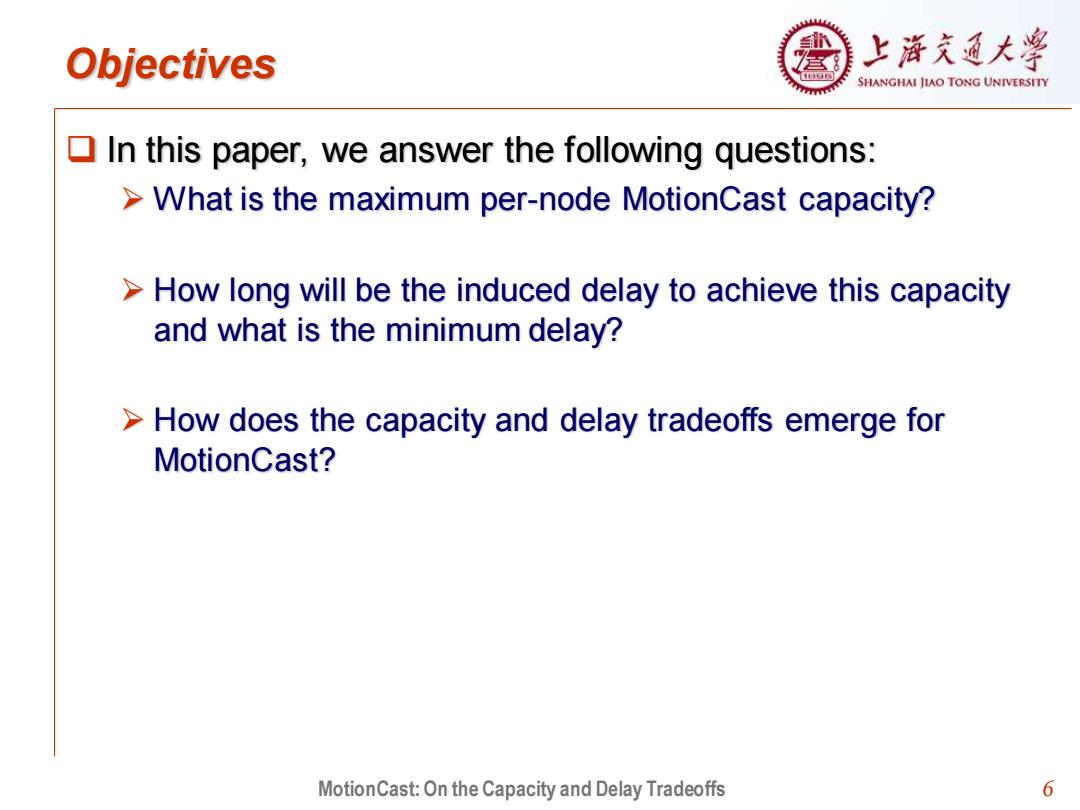
Objectives 上浒充通大¥ SHANGHAI JIAO TONG UNIVERSITY In this paper,we answer the following questions: >What is the maximum per-node MotionCast capacity? >How long will be the induced delay to achieve this capacity and what is the minimum delay? How does the capacity and delay tradeoffs emerge for MotionCast? MotionCast:On the Capacity and Delay Tradeoffs 6
MotionCast: On the Capacity and Delay Tradeoffs 6 Objectives ❑ In this paper, we answer the following questions: ➢ What is the maximum per-node MotionCast capacity? ➢ How long will be the induced delay to achieve this capacity and what is the minimum delay? ➢ How does the capacity and delay tradeoffs emerge for MotionCast?
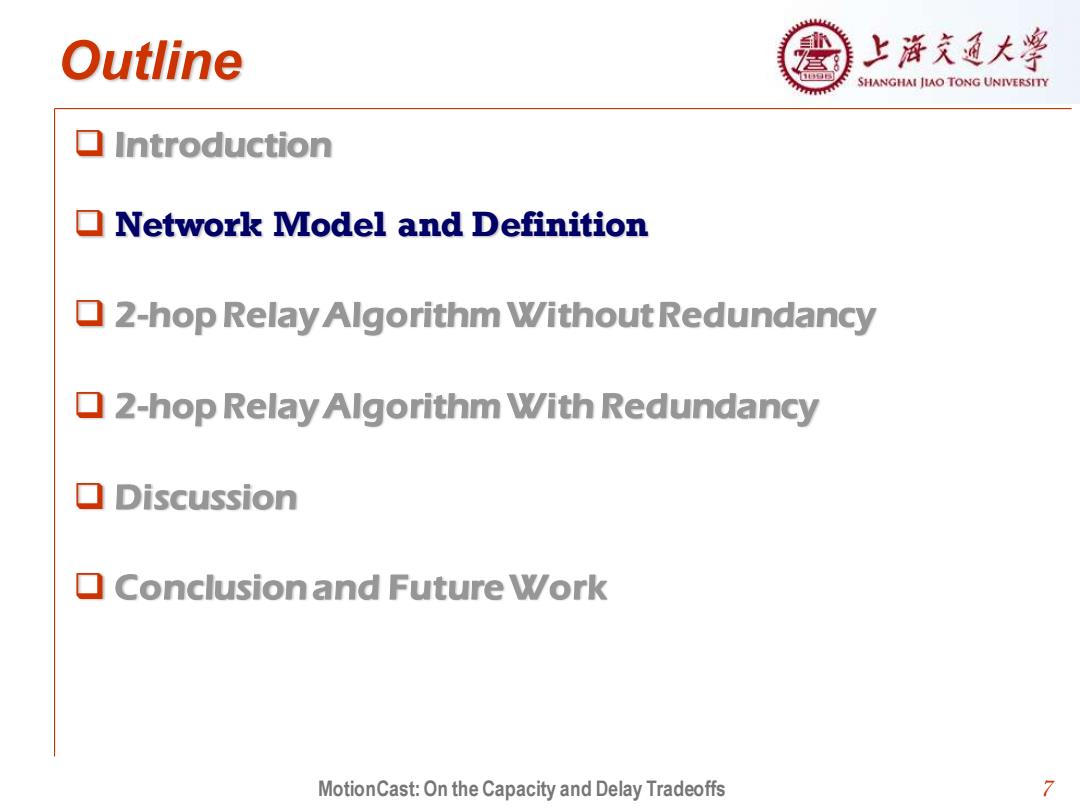
Outline 上浒充通大学 SHANGHAI JIAO TONG UNIVERSITY ▣Introduction Network Model and Definition Q2-hop Relay Algorithm Without Redundancy Q2-hop Relay Algorithm With Redundancy ▣Discussion Conclusion and Future Work MotionCast:On the Capacity and Delay Tradeoffs 7
MotionCast: On the Capacity and Delay Tradeoffs 7 Outline ❑ Introduction ❑ Network Model and Definition ❑ 2-hop Relay Algorithm Without Redundancy ❑ 2-hop Relay Algorithm With Redundancy ❑ Discussion ❑ Conclusion and Future Work
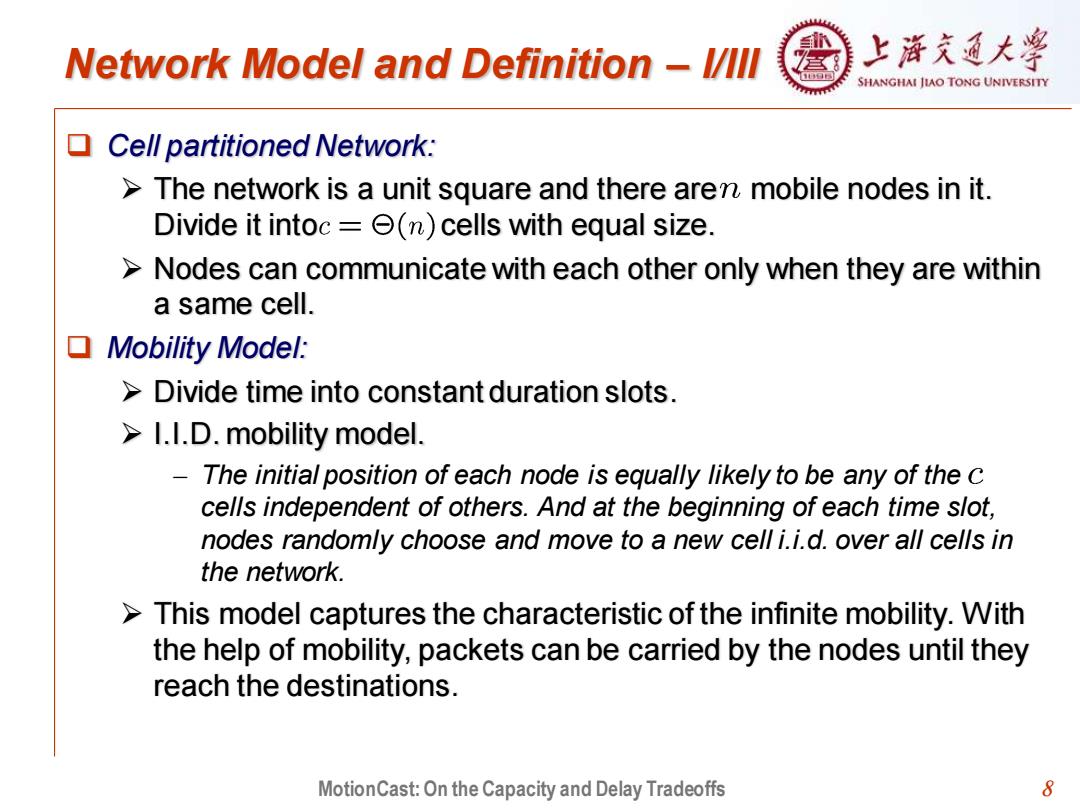
Network Model and Definition l/lll 上浒充通大学 SHANGHAI JIAO TONG UNIVERSITY Cell partitioned Network: The network is a unit square and there aren mobile nodes in it. Divide it intoc =e(n)cells with equal size. >Nodes can communicate with each other only when they are within a same cell. ▣Mobility Model: Divide time into constant duration slots. >1.I.D.mobility model. - The initial position of each node is equally likely to be any of the c cells independent of others.And at the beginning of each time slot, nodes randomly choose and move to a new cell i.i.d.over all cells in the network. This model captures the characteristic of the infinite mobility.With the help of mobility,packets can be carried by the nodes until they reach the destinations. MotionCast:On the Capacity and Delay Tradeoffs 8
MotionCast: On the Capacity and Delay Tradeoffs 8 Network Model and Definition – I/III ❑ Cell partitioned Network: ➢ The network is a unit square and there are mobile nodes in it. Divide it into cells with equal size. ➢ Nodes can communicate with each other only when they are within a same cell. ❑ Mobility Model: ➢ Divide time into constant duration slots. ➢ I.I.D. mobility model. – The initial position of each node is equally likely to be any of the cells independent of others. And at the beginning of each time slot, nodes randomly choose and move to a new cell i.i.d. over all cells in the network. ➢ This model captures the characteristic of the infinite mobility. With the help of mobility, packets can be carried by the nodes until they reach the destinations
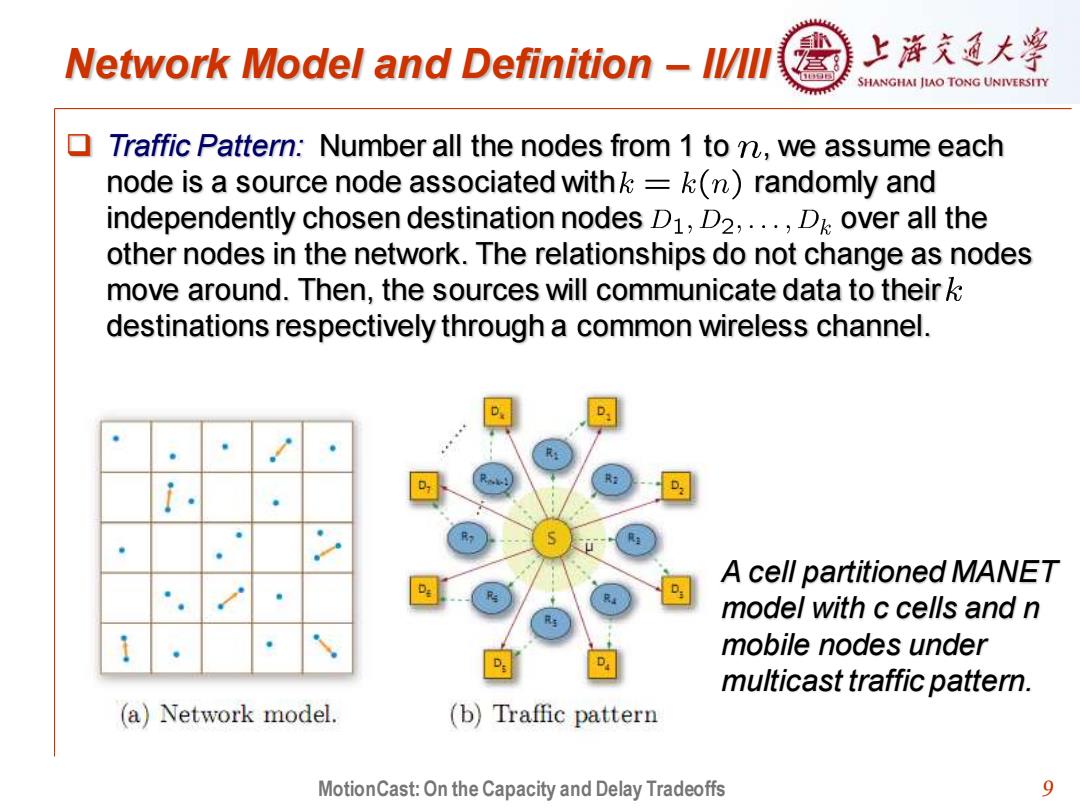
Network Model and Definition ll/lll 上浒充通大粤 SHANGHAI JIAO TONG UNIVERSITY ▣ Traffic Pattern:Number all the nodes from 1 to n,we assume each node is a source node associated with=k(n)randomly and independently chosen destination nodes D1,D2,...D over all the other nodes in the network.The relationships do not change as nodes move around.Then,the sources will communicate data to their destinations respectively through a common wireless channel. A cell partitioned MANET model with c cells and n mobile nodes under multicast traffic pattern. (a)Network model. (b)Traffic pattern MotionCast:On the Capacity and Delay Tradeoffs 9
MotionCast: On the Capacity and Delay Tradeoffs 9 Network Model and Definition – II/III ❑ Traffic Pattern: Number all the nodes from 1 to , we assume each node is a source node associated with randomly and independently chosen destination nodes over all the other nodes in the network. The relationships do not change as nodes move around. Then, the sources will communicate data to their destinations respectively through a common wireless channel. A cell partitioned MANET model with c cells and n mobile nodes under multicast traffic pattern
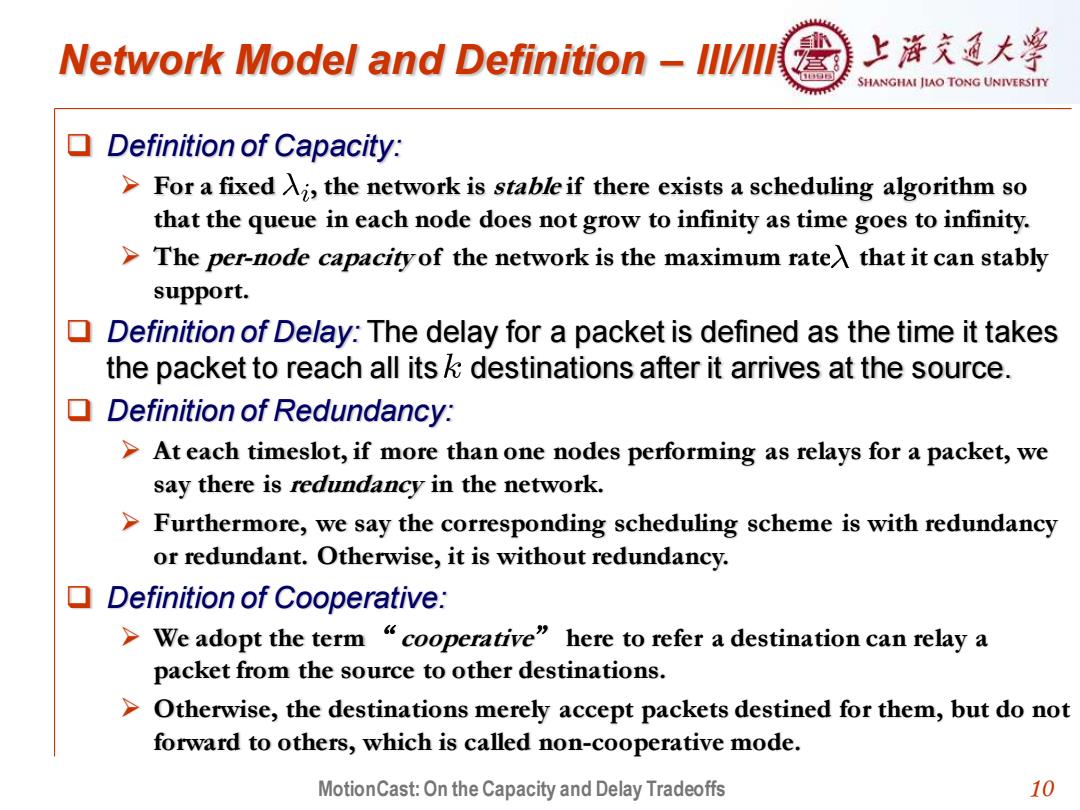
Network Model and Definition lll/II 上游充通大 SHANGHAI JIAO TONG UNIVERSITY Definition of Capacity: For a fixed Ai,the network is stable if there exists a scheduling algorithm so that the queue in each node does not grow to infinity as time goes to infinity. The per-node capacity of the network is the maximum rate that it can stably support. Definition of Delay:The delay for a packet is defined as the time it takes the packet to reach all its destinations after it arrives at the source. Definition of Redundancy: >At each timeslot,if more than one nodes performing as relays for a packet,we say there is redundancy in the network. > Furthermore,we say the corresponding scheduling scheme is with redundancy or redundant.Otherwise,it is without redundancy. ▣ Definition of Cooperative: >We adopt the term "cooperative"here to refer a destination can relay a packet from the source to other destinations. >Otherwise,the destinations merely accept packets destined for them,but do not forward to others,which is called non-cooperative mode. MotionCast:On the Capacity and Delay Tradeoffs 10
MotionCast: On the Capacity and Delay Tradeoffs 10 Network Model and Definition – III/III ❑ Definition of Capacity: ➢ For a fixed , the network is stable if there exists a scheduling algorithm so that the queue in each node does not grow to infinity as time goes to infinity. ➢ The per-node capacity of the network is the maximum rate that it can stably support. ❑ Definition of Delay: The delay for a packet is defined as the time it takes the packet to reach all its destinations after it arrives at the source. ❑ Definition of Redundancy: ➢ At each timeslot, if more than one nodes performing as relays for a packet, we say there is redundancy in the network. ➢ Furthermore, we say the corresponding scheduling scheme is with redundancy or redundant. Otherwise, it is without redundancy. ❑ Definition of Cooperative: ➢ We adopt the term “cooperative” here to refer a destination can relay a packet from the source to other destinations. ➢ Otherwise, the destinations merely accept packets destined for them, but do not forward to others, which is called non-cooperative mode